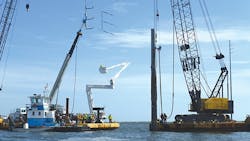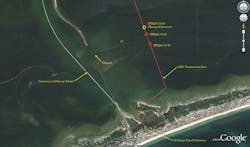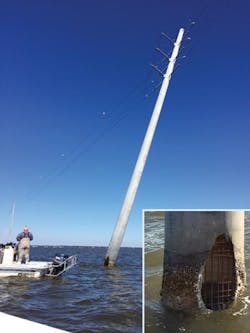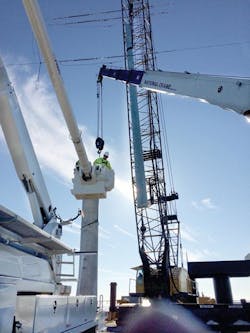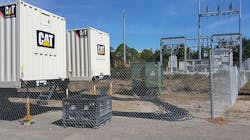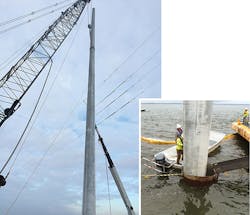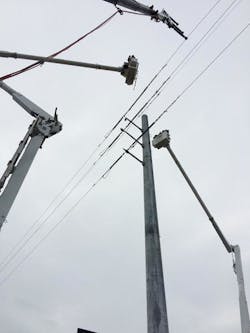Apalachicola Bay Pole Restoration
On Tuesday, Feb. 17, 2015, Richard Murray and Lance Martina, Duke Energy Florida substation electricians, were crossing the Apalachicola Bay on the causeway to visit the St. George Island (SGI) substation for regular maintenance. As the electricians looked east, out into the bay, something did not look right. It appeared a transmission structure was disoriented and leaning over the water. The electricians immediately pulled over and reported the situation, which initiated the St. George Island pole restoration project.
SGI is located in the panhandle of Florida, on the Gulf of Mexico, approximately two hours southwest of Tallahassee. It spans 28 miles (45 km), with a state park on the east end, a private gated community on the west end and a variety of vacation homes in between. The island is famous for its beaches, fishing and oysters.
One radial 69-kV transmission line feeds SGI’s 13-MVA peak load and spans the Apalachicola Bay approximately 5 miles (8 km). If any event occurs along this transmission line that causes an outage, the island is without power. Duke Energy Florida developed a contingency plan for this transmission line to enable quick mobilization if an emergency situation occurs.
Structural Damage
The bay is relatively shallow with oyster beds spread throughout. Large vessels navigate the bay through designated channels. The transmission line spans one of the channels with two 190-ft (58-m) hybrid structures comprised of a concrete base and a steel-top section. These two hybrid structures are identified as structures 41 and 42.
Located one span to the north of structure 41, structure 40 was a 140-ft (43-m), 24-kip concrete pole that weighed approximately 60,000 lb (27,216 kg). The structure was designed to withstand a 135-mph (217-kmph) wind load and an 18,000-lb (8165-kg) wave load at 11 ft (3.4 m) above the mean low-level water line. The foundation of structure 40 consisted of a 0.5-inch (12.7-mm) steel casing that was vibrated in to 35 ft (11 m) below the mud line. The mud inside the casing was then augured out, and the annular space within the casing was filled with crushed stone backfill to 1 ft (0.30 m) above the mud line.
Sometime prior to Feb. 17, structure 40 was struck by a large vessel that had veered out of the channel that traverses structures 41 and 42. After the initial call was made reporting the damaged structure, Duke Energy Florida leadership was notified and a visual inspection was requested to assess the damage. A local boat captain was dispatched, along with several Duke Energy Florida transmission line representatives to verify the extent of the damage.
Resources for Replacement
Structure 40 had failed — but not catastrophically — below the water surface, 18 inches (46 cm) below the top of the casing. The exposed portion of the structure, above the water surface, was leaning approximately 30 degrees off center. This was communicated back to transmission leadership, and it was confirmed structure 40 needed to be replaced.
Within 48 hours of the contingency plan being activated, the following equipment, materials and resources were delivered to SGI:
- Three barges
- Nine generators
- Two cranes
- Duke Energy substation maintenance crew
- Duke Energy transmission line maintenance crew
- Service Electric Co. transmission line crew
- Duke Energy distribution crew
- Duke Energy power, quality, reliability and integrity (PQRI) engineers
- Duke Energy security officers
- Duke Energy community relations manager
- Duke Energy inspectors
- Duke Energy project manager
- Ring power engineers
- Crane operators
- Barge operators
- Scuba divers
- All the associated transmission line material
- Command center
As all the equipment, materials and resources converged on SGI, the project team leaders were developing the construction plan to replace structure 40 successfully. During this planning period, transmission line engineering was engaged to determine if the conductor could be removed from structure 40 and floated between structures 41 and 39, while structure 40 was being replaced.
PLS-CADD and as-builts of the transmission line were used to verify the structural capacity of structures 41 and 39. Engineering was able to verify, during normal operating conditions, the additional loading caused by the removal of structure 40 and floating the conductor did not exceed the strength capacity of structures 41 and 39, or their insulators.
The Construction Plan
Armed with that engineering analysis, the construction plan was to take an outage on the line on Feb. 20, long enough for Service Electric to stabilize structure 40, float the conductor off the insulators, cut the top of the structure off and secure it on a barge. During the outage, it was determined SGI’s 13-MVA potential peak load would be fed by eight 2-MW, 480-VAC Caterpillar generators until the line was put back in service. The remaining line work in the bay would be done while the line was energized, using the live-line, bare-hand method.
SGI’s 2,100 customers are served by two 12-kV distribution feeders that total almost 120 circuit miles (193 circuit km). The contingency plan was the culmination of four unplanned outages to the SGI substation dating back to 2006, when the original wood-pole transmission line was significantly damaged in the bay by storm winds. During those events, the load had to be served by distributed Caterpillar generators for up to five days. These events drove the need to rebuild the transmission line in 2012 to the present high-reliability design.
The plan sectionalized SGI’s distribution system into five predetermined sections to place either single generators or two parallel generators. The 480-V generators were stepped up to 12 kV using 2500-kVA pad-mounted transformers then connected to the overhead distribution system through typical underground and overhead terminations. When the generators arrived at SGI, they were sent to their respective locations and immediately connected by Duke Energy substation maintenance and distribution crews familiar with the process. Eight generators were operational with one designated as a spare.
With an established date for the line outage, the Duke Energy Florida community relations manager of the area sent out several communications to SGI residents and business owners. Local law enforcement was notified and placed a warning sign just before the causeway going over to the island, communicating the power outage. The local newspapers ran notices, and the community relations manager went door to door in the business district. All the communications and notifications sent out indicated there would be an 8-hour power outage on the island on Feb. 20. Eight hours was the projected duration of the outage that would be needed and, in the event the generators did not work, the residents and business owners needed to prepare for the worst-case scenario.
Start the Clock
The morning of Feb. 20, the northern maintenance manager held a joint safety pre-job brief with all 13 work-group supervisors. Safety was paramount throughout this project. The work in the bay particularly was highlighted because of the challenging environment of working from barges over open water and fighting strong winds and currents. Equipment movement, drop zones and slipping hazards were constantly changing, so situational awareness was vital. A slip, trip or fall could result in a man overboard situation, on one of the coldest weeks Florida experienced in 2015. Life preservers and personal protective equipment were mandatory for any workers on the barges or bay boats.
After all the supervisors and crews dispersed to their assigned locations, the project leaders (the northern maintenance manager, substation maintenance supervisor, PQRI engineers, community relations manager and project manager) took their post in the command center. There was an anxious excitement in the room leading up to the start of the generators at 8 a.m. The command center is adjacent to the SGI substation, where four generators are located, and the sound of those units coming on-line started to fill the room.
The eight 2-MW, 480-VAC Caterpillar generators started taking load by 8:58 a.m., and then the calls started. The calls were progress reports on how the generators were handling the load. Several units tripped and the PQRI engineers worked feverishly to rebalance the load to get those units to stay on-line. The generators can only tolerate a 20-A imbalance (at 12 kV), which can be difficult to maintain on small sections of an established distribution feeder. By 10:20 a.m., the majority of the island was being carried by the generators.
At 10:18 a.m., the transmission line motor-operated switch was opened to kill the 69-kV feed to the SGI substation. At 10:30 a.m., the line disconnect switch was opened at the SGI substation, isolating the transmission line. Grounds were hung at 11:10 a.m., and the work in the bay began.
Service Electric immediately began stabilizing structure 40 with the barge crane. Once the structure was stabilized, the conductor was removed off the insulators and floated. When the conductor was safely out of the way, the top half of the structure was cut off and secured on one of the barges. All this work took 6 hours 13 minutes, with work completed at 5:23 p.m. The remaining transmission construction could be done with the 69-kV line energized.
The transmission line was reenergized at 6:25 p.m. up to the feeder breaker disconnect switches at the SGI substation. The generators were opened and isolated at 7:03 p.m., and the feeder breakers were closed in at 7:38 p.m., reenergizing SGI. In the end, 95% of the island never experienced a loss of power except for the 35 minutes it took between isolating the generators and closing the feeder breakers.
The Biggest Challenge
The transmission line outage was the largest challenge the project had to face, but the second-largest challenge would be removing the pole butt from the caisson. It could not be determined whether the pole butt would come out in one piece. The best-case scenario was if the pull butt came out in one piece and the caisson could be reused for the new structure. The worst-case scenario was if it broke into two pieces while being lifted out and a piece remained in the caisson, rendering it useless for the new structure. This would require a new caisson to be installed. And since this was a long lead time item, the new caisson would take one week to obtain.
The only way to know what the result would be was to lift the pole out. On Saturday, Feb. 21, 2015, Service Electric positioned the barges and equipment to lift the structure. Its first task was to capture the energized 69-kV conductors with its robotic arm. Once the conductors were captured, divers were deployed to mark the caisson location. When the caisson was marked, Service Electric attempted to pull out the structure.
It was a success, with the structure removed in one piece. It was determined the caisson did not experience any rotation or deflection and, therefore, could be used for the new structure. On Monday, Feb. 23, 2015, the caisson was cleaned out, the new pole was set and the conductors were transferred to the new insulators. The remaining transmission line construction was completed by 3 p.m. on Tuesday, Feb. 24.
An Overall Success
From the time structure 40 was reported in the bay on Feb. 17 until the transmission line construction was completed on Feb. 24, zero safety events occurred. An enormous amount of equipment, material and resources were mobilized to SGI within 48 hours. With eight Caterpillar generators holding the load, customer outages on SGI were kept to a minimal 35 minutes during an 8-hour, 45-minute transmission line outage on Feb. 20. Structure 40 was replaced successfully within five days under constantly changing conditions in the bay, working the majority of the project with the 69-kV transmission line energized.
Acknowledgement
This was a successful project for Duke Energy Florida and its SGI customers. It would not have been possible without the strong leadership from Troy Buis, Troy Bradfield, Doug Hurlock, Eddie Holman, Donald Kinney, Bobby Pickels, James Haugabrook, Randall Miranda, Shawn Spivey, Bill Chesney, Shaun Vance and Tim White.
Stephen Wood is a transmission project manager with Duke Energy Florida. He received a BSCE degree from the University of Central Florida and is a licensed professional engineer in the state of Florida. He has worked the past 18 months as a transmission project manager and the previous five years as a transmission substation civil engineer, all with Duke Energy Florida.
Gary Bitter is a lead engineer with Duke Energy Florida. His responsibilities and expertise are in distribution planning, reliability, system protection and operations. He is a leader in integrating new technologies and products into the Duke Energy distribution system. His experience spans 32 years, beginning as a co-op student with Georgia Power Co. Bitter holds a BEE degree from Georgia Institute of Technology, is a member of IEEE and is a licensed professional engineer in the state of Florida.
Editor’s note: This article is based on a project that will receive the Industry Excellence Award for the transmission line category at the 2016 Southeastern Electric Exchange meeting.
